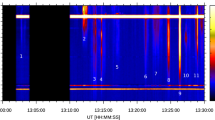Abstract
Thousands of decimetric spikes were observed with a new spectrometer of Yunnan Observatory on June 24, 2001. The statistical analyses of the bandwidth, polarization degree, and half power duration of these spikes were made. We found that the absolute bandwidth of the spikes is down to the low limit of the instrument’s spectral resolution (about 1.4 MHz). 76% of the total spikes have the polarization degree greater than 70%. The distribution of the half power durations concentrates on less than 16 milliseconds. These results support the interpretation of the electron cyclotron maser (ECM) mechanism for the decimetric spikes.
Similar content being viewed by others
References
Slottje, C., Millisecond microwave spikes in solar microwave flares, Nature, 1978, 275: 520–524.
Jin, S. Z., Zhao, R. Y., Fu, Q. J., Solar microwave bursts recorded at 2.84 GHz with millisecond time resolution, Solar Physics, 1986, 104: 391–413.
St ä hli, M., Magun, A., The microwave spectrum of solar millisecond spike, Solar Physics, 1986, 104: 117–123.
Benz, A. O., Millisecond radio spikes, Solar Physics, 1986, 104: 99–110.
Perrenoud, M. R., The computer-controlled solar radio spectrometer IKARUS, Solar Physics, 1982, 97: 97–106.
Benz, A. O., Güdel, M., Isliker, H. et al., A broadband spectrometer for decimetric and microwave radio bursts: first results, Solar Physics, 1991, 133: 385–393.
Csillaghy, A., Benz, A. O., The bandwidth of millisecond radio spikes in solar flares, Astron. Astrophys., 1993, 274: 487–496.
Messmer, P., Benz, A. O., The minimum bandwidth of narrowband spikes in solar flare decimetric radio waves, Astron. Astrophys., 2000, 354: 287–295.
Benz, A. O., Plasma Astrophysics — Kinetic processes in solar and stellar coronae, Dordrecht: Kluwer Academic Publishers, 1993.
Kundu, R., Vlahos, L., Solar microwave bursts: a review, Space Sci. Rev., 1982, 32: 405–421.
Güdel, A., Zlobec, P., Polarization and emission mode of solar radio spikes, Astron. Astrophys., 1991, 245: 299–309.
Wang, M., Fu, Q. J., Xie, R. X. et al., Observational characteristics of weak polarized microwave spikes, Solar Physics, 1999, 189: 331–344.
Winglee, R. M., Dulk, G. A., Electron-cyclotron maser emission from the Sun and stars: variations with plasma temperature and density, Solar Physics, 1986, 104: 93–97.
Güdel, A., Benz, A. O., Time profiles of solar radio spikes, Astron. Astrophys., 1990, 231: 201–212.
Author information
Authors and Affiliations
Corresponding author
Rights and permissions
About this article
Cite this article
Wang, M., Duan, C., Xie, R. et al. The spectral observation of decimetric spikes with very high spectral resolution. Sci. China Ser. A-Math. 45 (Suppl 1), 106–113 (2002). https://doi.org/10.1007/BF02889691
Received:
Issue Date:
DOI: https://doi.org/10.1007/BF02889691




